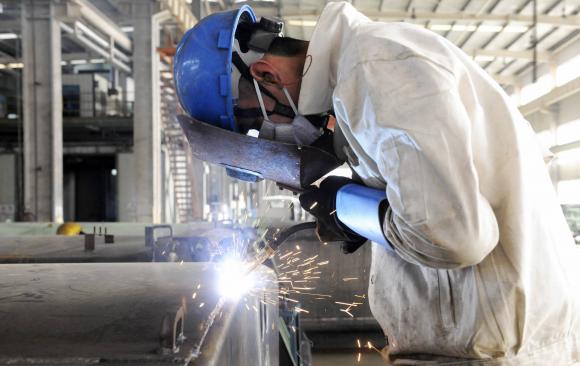Steady growth in second quarter but challenges ahead
Updated: 2016-07-19 07:46
By LOUIS KUIJS(China Daily)
|
||||||||
 |
|
An employee welds the exterior of a vehicle along a production line at a factory in Qingdao, Shandong province on Dec 1, 2014. [Photo/Agencies] |
China's overall economic growth held steady at 6.7 percent year-on-year in the second quarter, as better exports and steady infrastructure investment offset downward pressures from increasingly weak corporate investment and the spurt in real estate construction started to lose momentum.
However, overall growth is likely to be challenged in the second half of the year because real estate construction is likely to slow down further and the prospects for exports and corporate investment remain weak. Consequently, achieving the government's overly ambitious GDP growth targets will rely on continued stimulus. With the limits to credit-based stimulus becoming more obvious, the government may have to resort to a greater reliance on fiscal policy.
A look at the breakdown shows that growth in industry was a bit faster than in the first quarter and the expansion of services somewhat slower. Meanwhile, the pace of deflation in industry eased substantially, so the increase in the overall GDP deflator picked up significantly, allowing for nominal GDP growth to rise to 8.4 percent year-on-year, the fastest growth in two years.
Investment momentum weakened further in the second quarter, with overall fixed asset investment growth falling to 8.3 percent year-on-year. A spurt in real estate investment in early 2016 was crucial to countering the downward pressures on overall growth in the first half of this year, but, the pick-up in the real estate sector seems now to be losing momentum amid still high inventories of unsold housing. Growth in housing starts slowed further to 7.3 percent year on year in June alongside a further deceleration in housing sales. However, infrastructure investment remained solid through June, reflecting its use by the government as a means to stimulate the economy.
Consumption was robust, remaining an important cushion to the downward pressures. Although, according to the household surveys, growth of nationwide consumption fell from 7.5 percent year-on-year in the first quarter to 6.5 percent in the second quarter, in real terms, real retail sales growth picked up throughout the quarter, as did that of passenger car sales-the latter were up 17.7 percent on the year in June.
Headline total social financing (TSF) growth eased to 12.3 percent year on year in June. But, adjusted for local government bond issuance it was significantly higher at 16.7 percent on the year.
While GDP growth remained decent in the second quarter, in the second half of the year it will be challenged by the loss of momentum in real estate construction and subdued prospects for exports and corporate investment. Thus, the achievement of the government's overly ambitious growth target of between 6.5 and 7 percent will rely on further macroeconomic stimulus.
Recent developments and pronouncements on the policy front have confirmed that, in spite of speculation about a possible policy tightening, there are no signs of such a change-at least for now.
At the same time, however, developments in the economy show the limits of credit-based stimulus. Because of the lack of appetite among enterprises to invest, especially among private enterprises, the current credit expansion is having only a limited impact on the real economy. Instead, many corporates are hoarding cash. As a result, if the government remains adamant on meeting its growth targets, it may need to rely more on fiscal policy stimulus, especially consumption-oriented initiatives.
Meanwhile, the case for reining in credit growth is strong and it is still possible that the leadership may change course and decide to take action to slow credit growth, If accompanied by reforms to improve the allocation of capital and raise the role of equity finance, a strategy to rein in credit growth gradually but steadily could put China's growth on a more sustainable footing at manageable costs in terms of short-term growth and social consequences. But it would obviously require a re-interpretation of GDP growth targets through to 2020.
The author is head of Asia economics at Oxford Economics.
- African Union opens with launch of continental passport
- Baton Rouge shooter identified as ex-Marine Gavin Long
- Navy chiefs set for fresh talks on South China Sea
- Arrests hit 6,000 as Turkey cracks down on army and judges after coup bid
- A close look at Theresa May's new cabinet
- More than 70 dead in Nice attack as France marks national day

 Uphill battle for cyclists in downhill race in Zhangjiajie
Uphill battle for cyclists in downhill race in Zhangjiajie
 Shennongjia added to World Heritage List
Shennongjia added to World Heritage List
 Campers sleep perched on cliff face in Central China
Campers sleep perched on cliff face in Central China
 Two giant pandas meet public in NE China
Two giant pandas meet public in NE China
 Ongkor Festival celebrated in Southwest China's Tibet
Ongkor Festival celebrated in Southwest China's Tibet
 The world in photos: July 11 - 17
The world in photos: July 11 - 17
 Ten photos from around China: July 8-14
Ten photos from around China: July 8-14
 The only surviving panda triplets weaned from milk
The only surviving panda triplets weaned from milk
Most Viewed
Editor's Picks

|

|

|

|

|

|
Today's Top News
Ministry slams US-Korean THAAD deployment
Two police officers shot at protest in Dallas
Abe's blame game reveals his policies failing to get results
Ending wildlife trafficking must be policy priority in Asia
Effects of supply-side reform take time to be seen
Chinese State Councilor Yang Jiechi to meet Kerry
Chinese stocks surge on back of MSCI rumors
Liang avoids jail in shooting death
US Weekly

|

|







